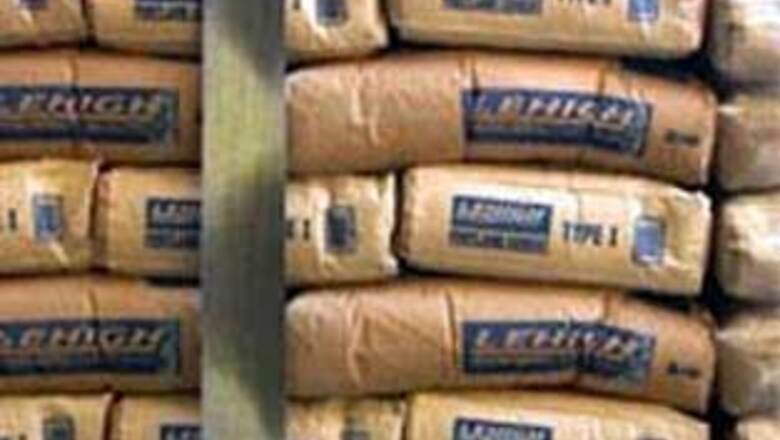
views
Cement stocks are trading well off their lows. They have underperformed for more than two-years. Some of those stocks have been relative outperformers and are trading well off their recent lows of 2008 in the last two months.
Industry veteran and VC, Reliance Natural Resources Limited (RNRL), Anil Singhvi, said, "The demand for cement is growing well and oversupply concerns are overplayed.Monthly cement despatches are encouraging."
According to him, demand for housing, infrastructure still persists and the effect will be felt more by large players. He expects 6-7 per cent growth even in worst fundamental conditions. He says cement prices are likely to remain stable. He sees 2-3 per cent spike in cement prices before peak season ends.
Here is a verbatim transcript of Anil Singhvi's comments on CNBC-TV18. Also watch the accompanying video.
Q: What is your sense after such underperformance for more than two years? Do you think from a cyclical perspective the worst is over for the sector?
A: There are two aspects to it. I would not like to comment first on how stocks have faired but I would look at how companies have been fairing. In the last two years, the companies have by and large faired well. The two major impediments before the industry — one was the overcapacity and second was whether the demand will grow in-line with the growth of last 4-5 years. But I am glad that the demand seems to be really growing well and all the oversupply concerns were overplayed by the markets. So, stock market was reacting to these two situations— first economy slowing down and second we may get into
over-capacity. Let me dwell here on over-capacity. People talked of the100 million tonne of new cement capacity to be added in 2-2.5 year's time. But I was never of that view that 100 million tonne would have been created. Making announcement in India is very fashionable and they keep on making announcements for various things, cement included in that. But one needs to look at the ground reality and I am happy that this is not as devilish as it was looking about 2 years back.
Second is the issue of demand, which perhaps has surprised all the analyst and proved them wrong. Despite of all talk of the economy slowing down, we haven't seen that kind of demand slowdown in cement and last four months numbers have been very good. Each month successively we are doing 16 million tonne of cement dispatch. I think all this shows that all is not bad as far as the construction industry is concerned. We often get guided by real estate prices and how developers have done. We look at DLF's share and get very worried about the cement shares. I think those are uncalled for reactions.
Q: Let me narrow that target down even more — 50 million tonne to be commissioned over the next 12 months. Don't you think that is going to happen?
A: I don't think so. I don't think ever in India you are going to have 50 million tonne coming in one year. That is not a joke. All these capacities and people talk about 3 million tonne plant and stretch it to a 5 million tonne plant and as soon as the plant is ready – and it not like buying a car that next morning you can speed it out. It takes almost about 6-12 months before a plant is stabilised. So, all the concerns on capacity is completely unfounded. We have seen in 2008-09 people talking about 30-40 million tonne and what we are seeing is less than 20 million tonne coming up as a capacity and productivity is still lower. All cement plants I am told are working at the full capacity and that is very encouraging in this time.
Q: The thing that has happened these past few months is that we are hearing lots and lots of reports of how much pricing is spiking across various regions. Do you put that down to a function of a pre-monsoon spike that you usually see in cement prices or do you think something is turning around on the pricing front?
A: Let me put it into perspective. I think in Mumbai when we talk about monsoon, we take it from June to September but in India it is just about 2 months, which is in July and August and perhaps in October and November in the South. So, monsoon is not that much of an impact that this is a pre-monsoon demand, which is coming up and come monsoon, everything will break loose. No, I don't think so. I think we have to give this credit to cement that despite all these concerns and call for the real estate not doing well, I think we are seeing construction. My own take is that when visiting smaller cities, I would take the example of Ahmedabad, Jaipur or any other cities in this country, I think construction industry is doing well maybe it is the large developers, who are finding that all of a sudden there is a problem that there is excess supply of that. But there is demand for housing, infrastructure and all those sorts of activity. So, maybe some sectors in construction industry of retail segment or very large malls coming up or very large residential complexes maybe are finding it little more difficult to sell the product. But I don't think there is any problem as far as demand for cement for the classical housing sector is concerned, which talks about repairing, renovation, extension and new houses built. I think all four activities are doing well.
Q: What is your assessment at how much cement off-take will grow in FY10 and whether you will see net-net some kind of average price realisation dip or increase through FY10?
A: I think this year we will finish it at around 8 per cent or so, growth at around 180 million tonne and next year even in a dooms day scenario I am putting it that everything is going bad in 2009-10, which most people are talking about. I think cement will still grow by 6-7 per cent. My real estate scenario is 6-7 per cent growth on 180 million tonne, which will take us almost about close to 195 or so.
PAGE_BREAK
Q: What about in terms of average realisations and prices through the year?
A: I think we have seen cement prices being one of the most stable prices. In fact, if I demolish the whole theory that cement is a commodity, which I have often argued very valiantly but always been a sufferer on account of analyst wisdom and their word saying that cement is a commodity but cement is not a commodity and I am going to repeat it, cement is not a commodity and this time it has proved like never before. All commodity complexes have collapsed and cement prices have remained stable and perhaps firm in the last 3 months. So my guess is that cement prices will remain more or less stable. We may see a small spike just before this peak season which we are already seeing from March-April-May, maybe 2 per cent-3 per cent increase.
But the positive for cement is that the energy cost has come down. Coal cost has come down; transportation cost will come down as we see the diesel prices coming off. So, we may see a little bit of a positive uptake on the Earnings before Interest, Taxes, Depreciation, and Amortization (EBITDA) margin for cement industry for the quarter of March and going forward even in June. We should be much better than June 08.
Q: We were talking about global brokerage report this morning, which said that for most infrastructure projects they are running behind schedule, brownfield and greenfield whether it is lack of finances or because of regulatory hurdles — would you say that is a fair reassessments of the situation on ground right now that the most infrastructure projects are probably going to get dragged a whole lot more than the kind of stipulated period, people who are working with.
A: I think the pendulum has swung completely from over-optimism to over-pessimism. I think we all seem to be sufferer of that. But if one moves oneself away from this pendulum swing I think things are not as bad as it has been meted out. If you have good projects money is still available but if one is really running for a completely suspect project perhaps, one has a problem. There has been some delay because the banking sector perhaps went for a vacation from October till December but I think the banking industry is back on the roll. They want to give money but the only thing is that they have become very choosy in terms of whom they should be giving money because earlier the risk was not priced and now we are pricing the risk. So, from a very excessive situation of money being available it has become selective that is where many people are finding it that things are slowing down and money is not available. I do not think on a ground reality, the situation is so bad as it has been meted out. I see saving rate going up this year because most people will have a bit of holding their hand. So, in that scenario banks will have a huge fixed deposits coming in. So they would be a washed with liquidity despite governments planning for very large borrowing between now and till July or so. Still we will find banking industry having lot of surpluses with them to fund the projects which are good, viable and robust.




















Comments
0 comment